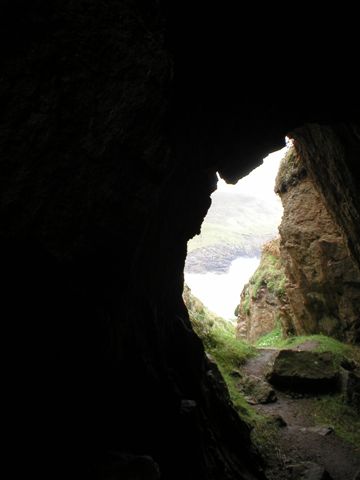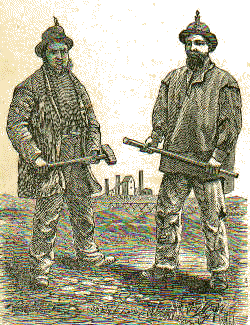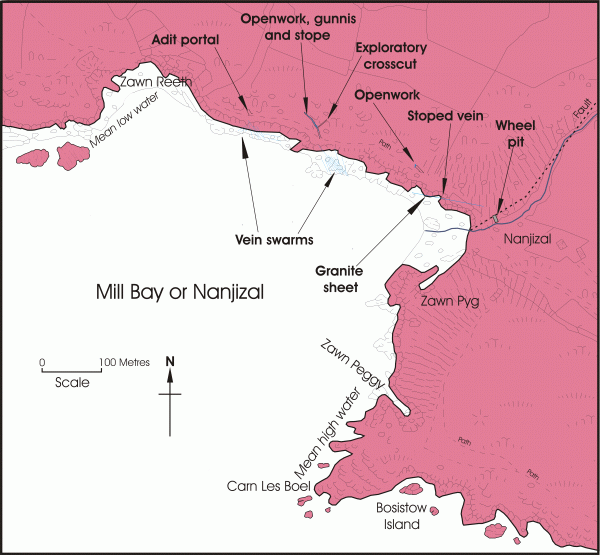

Mining in Sennen

Looking out from Nanjizel Mine
1703 AD:- Henry Vingoe's Tin Bounds.
There is very little history of mining in Sennen Parish. Whilst researching my wife's Vingoe family line, George I visited the Courtney Library at the Royal Cornwall Institute in Truro and found a document dated 1703. This was issued by the Stannary of Penwith in the name of John Grenville who was the Custodian and Guardian of the Stannary. Other officers mentioned where Ephraim Weymouth and Noye Edwards. The document is signed William Cock.
The document is written in a shorthand Latin and also includes Cornish place names. If you click on the image you will be able to see a larger image.
I was lucky enough to have the help of the late H. L. Douch at the Courtney Library, Truro. He gave me a quick translation of the main points in the document.
The document is a licence agreement on tin bounds at a place called Gweals Vean. Gweals is Cornish for field or work place, whilst Vean means little.
The bounds belonged to Henry Vingoe and he was letting them to William Borlase, the son of Joseph Borlase of St Just in Penwith, William Millett the son of Martin Millett also of St Just in Penwith and his own son Henry Vingoe Jnr. These bounds are bordered on the four sides by Carn Colwidrocke, Sowen Peddenantes, Vaan Vrease and Mean Sebmen.. The Date on the document is 1703.
Further
research at the Courtney Library turned up a document entitled:-
1738 AD:- "A Survey of Tin Bounds, The Property of Sam. Borlase and Others."
This is another paper discovered in the archives of the Courtney Library. The date on this document is 1783 and in it we found just one mention of the Parish of Sennen. This appertained to bounds owned by John Pascoe and others which were mined by S Borlase 1/3, I Millett 1/3 and A Pearce 1/3. There is included a sketch map of the bounds showing it to be on Trevescan Cliff. with the tin load being shown as running North to South going out to sea to the East of Dr Syntax's Head. These Bounds took in the whole of what we would refer to as the Lands End.
1871:- TOOLS OF THE CORNISH MINER
The
Cornish miner had to find his way through rock of a very difficult character,
sometimes consisting of solid granite, or elvan rock of excessive hardness. His
tools were few, but they were well adapted to their job; consisting, besides
those represented in the following engraving, of a small wedge or two of steel,
denominated a 9ad, which is driven into the rock by the round end of
the pick, for the purpose of splitting and detaching portions from the mass.

1 2
The
instrument, No. 1, is the pick of the miner; 2, the shovel; 3, the sledge; 4,
the borer; 5, the claying bar; 6, the
needle, called by some the nail; 7, the scraper; 8, the tamping bar; and 9,the
tin cartridge, for blasting where the rock is wet: add to these a horn to carry his
gunpowder, rushes to supply him with fuses, and a little touch-paper, or slow
fuse and you have the equipment used by the Cornish miner.
The
Nanjizal Mine.
Anyone walking the coast path from Lands End to Porthcurnow will pass the Nanjizal mine. Most will not even notice the workings as their eyes will be on the beautiful scenery around the Bay. Just when this mining commenced is unknown but it was in production in 1845 when Joseph Carne presented a paper at the Royal Geological Society of Cornwall. The following report comes from the Mining Gazette of the 8th of November 1845.
"SINGULAR DEPOSIT OF TIN ORE AT NANGIZELL COVE, NEAR THE LANDS END" Mr Carne read a paper at the Royal Geological Society of Cornwall, on this subject. Nangizell Cove is situate between Tol Pedn Penwith and the Lands End; on the very edge of the cliff is a stamping-mill for pulverising tin ore, worked by a water wheel. On looking round the cove, and the hills which bound it, the visitor discovers no appearance of a mine in all the neighborhood; he soon perceives, however, two spots on the slope of the hill, where small heaps of rubbish intimate that an attempt at mining may have been made, but there is no shaft, no adit, no machinery of any kind. At the most eastern spot an excavation has been made in the side of the hill, having the appearance of a stone quarry. The whole country is granite, and at the end of the excavation appears a mass of black schorl rock, which contains tin, and, by blasting a considerable quantity has been separated, and has been pulverised by the stamping-mill. The schorl rock is a mixture of schorl and quartz, in which the former greatly predominates - as hard flint - while the granite which incloses it is comparatively soft. Had the mass of schorl rock been continuous it would appear like a north and south vein, as it does not incline more than three feet in a fathom; but as it seems only an insulated mass the miners call it a floor; it is visible for about twenty feet in height. In the highest part of it which can be seen, it is about seven feet wide, but it spreads out to at least sixteen feet in the lowest part. At the second heap of rubbish in another similar deposits, which the miners have pursued about 100 feet into the hill, and have found it from one to eight feet wide, inclining at an angle of fifteen degrees from the perpendicular. When the present miners commenced their operations, there were evident marks that the spot had been wrought by others long before, who probably followed the floor as long as they found tin in it. The present workmen have pursued the floor into the hill; they have found the extent of the schorl rock above and below them; they are still, however, following it northward into the hill, but southward, in the rocks of the perpendicular cliff, there is no appearance of either of these floors; had they been veins, they must have intersected the rocks. No veins have been discovered in the direction of the floors, but there are several minute veins crossing the schorl rock, and where they intersect it, it is most productive of tin. These small veins, therefore, seem to occupy the same place, and to perform the same office to the schorl rock as feeders do to the regulat veins. The masses of schorl rock appear to be contemporaneous with the granite. How far the tin was of the same age, was a question which Mr. Carne would not undertake to decide. Mining Gazette, 8th of November 1845.
|

Adit Portal Open Work Gunnis Crosscut Wheel Pit The stream flows
into the bay
Tin Miners of Sennen
On the 1841 Census the following men of Sennen were involved in mining. Whilst it is possible that they were working at Nanjizal it could be that they walked to mines in the St Just parish. It is interesting to note that all of them except Thomas Uren, lived between Sunny Corner and the St Just boundary area of the parish.
Name Age Living Born Thomas Uren, 20, Miner, Treeve William White, 55, Miner, Escalls Richard Nicholas, 20, Miner, Escalls William Nicholas, 50, Employed in Tin Mine Escalls Simon Mitchall, 25, Employed In Tin Mine Escalls Charles Nicholas, 35, Employed In Tin Mine Escalls Stephen Humphreys, 45, Employed In Tin Mine Escalls William Guy, 15 Employed In Tin Mine Escalls John George, 60, Employed In Tin Mine Sunny Corner William Walters, 30, Employed In Tin Mine Sunny Corner John Warren, 50, Employed In Tin Mine Carlidya Matthew Nicholas, 50, Employed In Tine Mine Carlidya
|
By the 1851 Census only one of the miners, William White, on the 41 census was still shown as mining
|
Name Age Employed Living Born James Oats 30 Miner Little Skewjack St Just John Nicholas 70 Tin Streamer Carlidga St Levan William White 66 Tin Streamer Escalls Sennen John Oats 36 Miner Escalls St Just Richard Nicholas 39 Miner Escalls Sennen William Thomas 14 Miner Escalls St Just William Nicholas 43 Miner Escalls Sennen William Nicholas 19 Miner Escalls Sennen William White 25 Miner Pulldown Sennen
|
By the 1861 Census the following Sennen men were working in the mines.
|
Name Age Employment Living Born William White 35 Tin Miner Pulldown Sennen Lysle Nicholas 16 Tin Miner Escalls Sennen Jesse Nicholas 15 Tin Miner Escalls Sennen John Oats 46 Tin Miner Escalls St Just John Oats 16 Tin Miner Escalls Sennen Richard Oats 15 Tin Miner Escalls Sennen Francis White 24 Tin Miner Escalls Sennen
|
By the 1871 census the following Sennen men were working in the mines.
|
Name Age Employment Living Born Zacheus Nicholas 19 Miner Escalls Sennen William Barnes 37 Miner Escalls St Just William Barnes 16 Miner Escalls Sennen
|
By the 1881 census there were no Sennen men were working in the mining industry and this remained the case in the 91 and the 1901census.
click on photos to see a larger version.
notes on the coinage of tin
in devon and cornwall in 1595.
As
reported in the state papers of the Reign of Elizabeth 1st of England.
Vol.CCLIII.
July.
45. Note of the ordinary days of coining tin in Devonshire and
July.
46. Answers [by Thios. Myddletois I] to instructions concerning the coinage of
tin in Devonshire and Cornwall, Midsummer 1593. I have attended the coinage,
and, kept a book of the weights, but found no abuse. Midsummer coinage began at
Chagford, 12 June, and ended at Helstone, 9 July; but there is an after coinage,
at which the officers have 12d. for each piece of tin. Michaelmas coinage begins
15 September and lasts to 9 October, after which the accounts are delivered to
Wm. Nele, the Queen’s auditor. There is a part coinage about Christmas, the
Queen receiving 4 per cent, for licence, which is 001. a year, and the officers
12d. each piece of tin. Statement
1,3..1,SOlhs. The tinners cannot tell how much is exported, as merchants and pewterers sometimes deal for each other. It used to be all sent to France till the Ronen trade was stopped, and this price came down; then the Londoners bought for the Straits and the Low Countries; now it is sold in Turkey, France, and Flanders.
-----------------------------------------------------------------------
WEB MASTER
george<at>penhalvean.freeserve.co.uk.
Cut and paste the address into your browser replacing <at> with @ .
This has been done in order to stop some of the span we recieve.